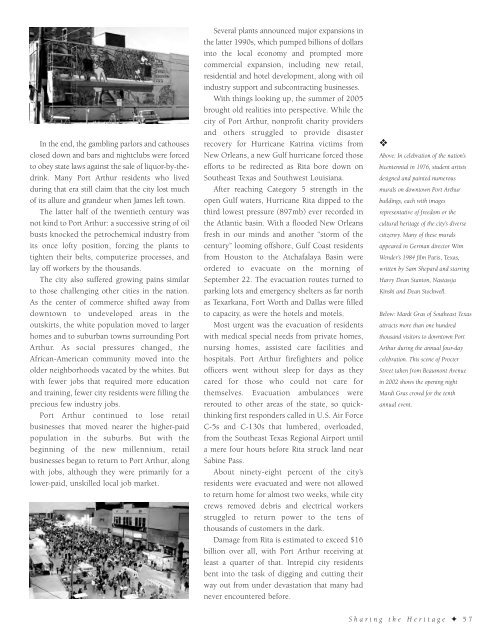Water Rails & Oil - Historic Mid & South Jefferson County
An illustrated history of the Mid and South Jefferson County area, paired with the histories of companies, families and organizations that make the region great.
An illustrated history of the Mid and South Jefferson County area, paired with the histories of companies, families and organizations that make the region great.
Create successful ePaper yourself
Turn your PDF publications into a flip-book with our unique Google optimized e-Paper software.
In the end, the gambling parlors and cathouses<br />
closed down and bars and nightclubs were forced<br />
to obey state laws against the sale of liquor-by-thedrink.<br />
Many Port Arthur residents who lived<br />
during that era still claim that the city lost much<br />
of its allure and grandeur when James left town.<br />
The latter half of the twentieth century was<br />
not kind to Port Arthur: a successive string of oil<br />
busts knocked the petrochemical industry from<br />
its once lofty position, forcing the plants to<br />
tighten their belts, computerize processes, and<br />
lay off workers by the thousands.<br />
The city also suffered growing pains similar<br />
to those challenging other cities in the nation.<br />
As the center of commerce shifted away from<br />
downtown to undeveloped areas in the<br />
outskirts, the white population moved to larger<br />
homes and to suburban towns surrounding Port<br />
Arthur. As social pressures changed, the<br />
African-American community moved into the<br />
older neighborhoods vacated by the whites. But<br />
with fewer jobs that required more education<br />
and training, fewer city residents were filling the<br />
precious few industry jobs.<br />
Port Arthur continued to lose retail<br />
businesses that moved nearer the higher-paid<br />
population in the suburbs. But with the<br />
beginning of the new millennium, retail<br />
businesses began to return to Port Arthur, along<br />
with jobs, although they were primarily for a<br />
lower-paid, unskilled local job market.<br />
Several plants announced major expansions in<br />
the latter 1990s, which pumped billions of dollars<br />
into the local economy and prompted more<br />
commercial expansion, including new retail,<br />
residential and hotel development, along with oil<br />
industry support and subcontracting businesses.<br />
With things looking up, the summer of 2005<br />
brought old realities into perspective. While the<br />
city of Port Arthur, nonprofit charity providers<br />
and others struggled to provide disaster<br />
recovery for Hurricane Katrina victims from<br />
New Orleans, a new Gulf hurricane forced those<br />
efforts to be redirected as Rita bore down on<br />
<strong>South</strong>east Texas and <strong>South</strong>west Louisiana.<br />
After reaching Category 5 strength in the<br />
open Gulf waters, Hurricane Rita dipped to the<br />
third lowest pressure (897mb) ever recorded in<br />
the Atlantic basin. With a flooded New Orleans<br />
fresh in our minds and another “storm of the<br />
century” looming offshore, Gulf Coast residents<br />
from Houston to the Atchafalaya Basin were<br />
ordered to evacuate on the morning of<br />
September 22. The evacuation routes turned to<br />
parking lots and emergency shelters as far north<br />
as Texarkana, Fort Worth and Dallas were filled<br />
to capacity, as were the hotels and motels.<br />
Most urgent was the evacuation of residents<br />
with medical special needs from private homes,<br />
nursing homes, assisted care facilities and<br />
hospitals. Port Arthur firefighters and police<br />
officers went without sleep for days as they<br />
cared for those who could not care for<br />
themselves. Evacuation ambulances were<br />
rerouted to other areas of the state, so quickthinking<br />
first responders called in U.S. Air Force<br />
C-5s and C-130s that lumbered, overloaded,<br />
from the <strong>South</strong>east Texas Regional Airport until<br />
a mere four hours before Rita struck land near<br />
Sabine Pass.<br />
About ninety-eight percent of the city’s<br />
residents were evacuated and were not allowed<br />
to return home for almost two weeks, while city<br />
crews removed debris and electrical workers<br />
struggled to return power to the tens of<br />
thousands of customers in the dark.<br />
Damage from Rita is estimated to exceed $16<br />
billion over all, with Port Arthur receiving at<br />
least a quarter of that. Intrepid city residents<br />
bent into the task of digging and cutting their<br />
way out from under devastation that many had<br />
never encountered before.<br />
❖<br />
Above: In celebration of the nation’s<br />
bicentennial in 1976, student artists<br />
designed and painted numerous<br />
murals on downtown Port Arthur<br />
buildings, each with images<br />
representative of freedom or the<br />
cultural heritage of the city’s diverse<br />
citizenry. Many of these murals<br />
appeared in German director Wim<br />
Wender’s 1984 film Paris, Texas,<br />
written by Sam Shepard and starring<br />
Harry Dean Stanton, Nastassja<br />
Kinski and Dean Stockwell.<br />
Below: Mardi Gras of <strong>South</strong>east Texas<br />
attracts more than one hundred<br />
thousand visitors to downtown Port<br />
Arthur during the annual four-day<br />
celebration. This scene of Procter<br />
Street taken from Beaumont Avenue<br />
in 2002 shows the opening night<br />
Mardi Gras crowd for the tenth<br />
annual event.<br />
Sharing the Heritage ✦ 57
















